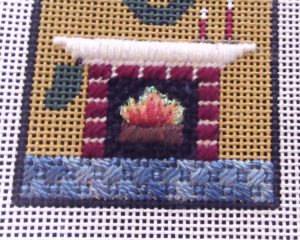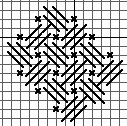
I’ve often found floors in needlepoint to be a problem. It’s OK if they are wood or tile, I know stitches for that and I can find threads that work. I can even figure out ideas for rugs. But what if your needlepoint room has good old wall-to-wall carpeting?
The color is easier, but what about the stitch? If you want something with more texture than Tent Stitch you might be out of luck. Today we’ll look at several types of carpet and the stitches and threads to use to stitch them.
Shag Rugs
Shag rugs and carpets aren’t very popular these days, but you may find yourself wanting to stitch one. Turkeywork is the best choice for this because it will give you an authentic shag look, but it must be done carefully. Make the Turkeywork as you normally would, but when trimming, plan to trim the stitching very, very short. If you do not, the Turkeywork will look loose and on a scale too large for your needlepoint.
Threads for this carpet can also have a scale problem. The threads you use should be very thin. Stranded threads such as silk or cotton floss, Mandarin Floss, or crewel wool are best. These threads will spread out making your shag look realistic.
Berber
These carpets with neutral colors and looped piles were very popular in the 1990’s. You still can often find them. Because their pile is looped over instead of cut, a stitch with a small granular texture is great for Berbers. My stitch of choice here is Needlepoint Cross Stitch, below. This stitch is the same size as Tent but when combined with other stitches looks more granular.

Threads to make these carpets are a bit more challenging because they are always heathered, so several values of the same color are combined. If you can find a heathered wool thread, use it. Some options would be Burmilana, Rainbow Tweed, and Heather from & more. The colors of these carpets tend to be light, so pick lighter colors.
If you cannot find a heathered thread, make your own using two or more shades and crewel wool. These shades should be different values of the same color.
Sculpted Pile
The carpet in my fireplace piece is another style that is less common these days, but it was very popular from the 1950’s through the early 1980’s. These carpets, while still a single color, had more complex patterns cut into the pile. Sometimes more than one texture appeared as well.
Replicating this in needlepoint is hard, once again because of the scale problem. I was excited to see how well the combination of Criss-cross Hungarian with Crosses, below, and a soft semi-solid thread, gave the same feel, picture at top of article.

Patterned Carpets
Carpet with patterns in more than one color are not as common in homes, but you find them all the time in commercial spaces. You do find in homes, however, a couple of subtly patterned carpets that can work well when stitched.
My favorite is the dotted carpet. To make this you will need either two threads the same color in contrasting textures or two of the same thread in different shades of the same color. Stitch the rug in Dotted Swiss, below, using one thread for the background and the other for the dots. The result will look as if there is a pattern or slight sculpting in the carpet.

Another option is a striped carpet. Here you will want several closely related shades of the same thread. While these carpets tend to have a greater range of shades, keeping the threads in a narrow range will keep the rug from overwhelming your piece. Pick your threads at random and stitch using Continental. Begin and end each thread in different places so that the stripes are of random lengths. This is a busy carpet, but can be an interesting one. It also works to stitch rag rugs, using one color per row.
Low-pile Carpet
If your carpet isn’t a special weave and doesn’t have a pattern, it’s probably a low-pile carpet. These are best stitched in Tent. Although you can use any thread for these my choice would be crewel wool. It will give you a realistic but smooth look.
About Janet M Perry
Janet Perry is the Internet's leading authority on needlepoint. She designs, teaches and writes, getting raves from her fans for her innovative techniques, extensive knowledge and generous teaching style. A leading writer of stitch guides, she blogs here and lives on an island in the northeast corner of the SF Bay with her family

Leave a Reply